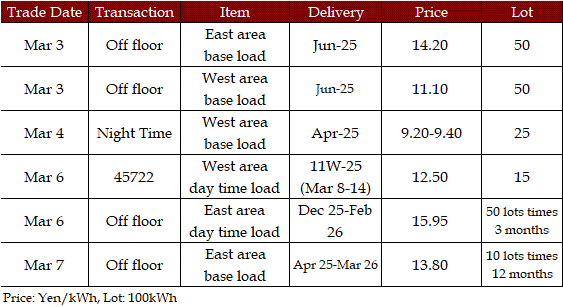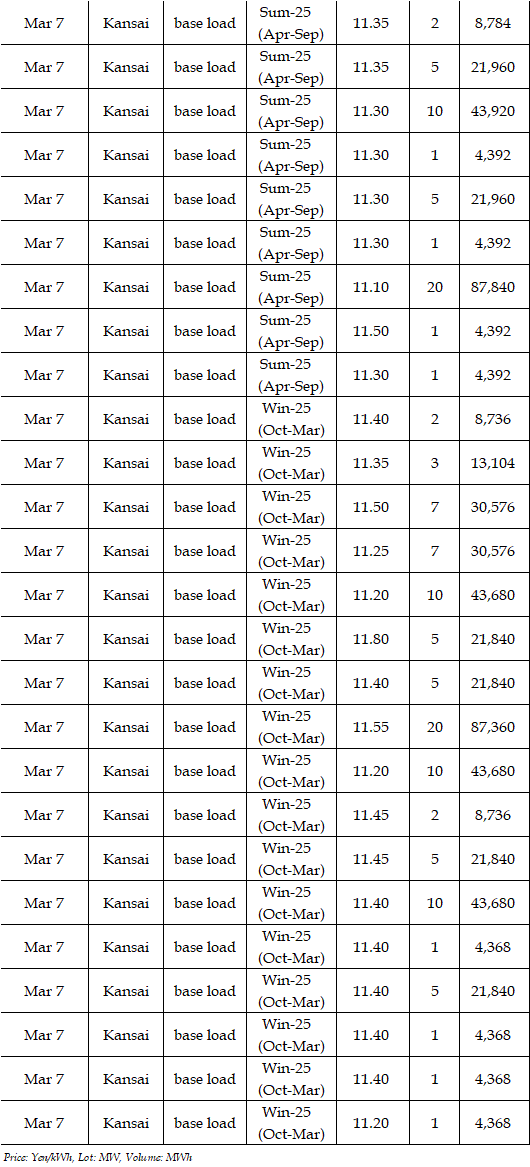|
In the day-ahead market on JEPX (Japan Electric Power Exchange), the 24-hour spot power prices on a weekly average basis for Mar 3-7 delivery bounced back from the previous week in both East Japan (50Hz) and West Japan (60Hz). Especially, West Japan accelerated the rally from the previous week, hitting the year high of the Yen 45 level for Mar 6-7 delivery. Many players regarded the remarkable price hike in West Japan as "beyond expectations" and "too much exaggerated even with the outlook for freezing climate". A source at a power producer and supplier said, "I believe a specific player is raising its bids." A source at another power producer and supplier said, "It is still cold in morning and night time while an increasing number of thermal units stop operation for regular maintenance. Still, supply-demand fundamentals are not so tight. In this sense, it is hard to understand why West Japan marked this kind of high price." A source at a mega power producer said, "In the JEPX auction, offers never decreased irregularly or bids did not expand unusually either. In this sense, I suspect bid levels by buyers could have affected the trade levels." A source at a third power producer said, "West Japan could continue choppy price movements in the non-peak demand period going forward, so that we will closely monitor the price trends." With more thermal units scheduled to halt run for regular maintenance in the non-peak demand period, many players were worried that lower reserve rates could push spot prices higher.
In Tokyo and Kansai, the key areas in East Japan and West Japan, the 24-hour average posted a hefty difference in favor of the West by Yen 2.26 for Mar 3 delivery, Yen 9.64 for Mar 4 delivery, Yen 2.21 for Mar 5 delivery, Yen 3.99 for Mar 6 delivery, and Yen 2.75 for Mar 7 delivery.
The fuel market trends in the first week of March were detailed as follows.
DES Northeast Asia spot LNG prices stood at $13 per mmBtu for prompt April 2025 arrival as of Mar 6, declining further by 80cts from the end of the previous week (Feb 28). A weakness in European natural gas prices dragged down the LNG market in Northeast Asia. Besides that, an unabated slump in buying interest from Northeast Asian end-users also capped upside room in spot prices. The Ministry of Economy, Trade and Industry (METI) announced on Mar 5 that Japan's LNG inventories for power generation stood at 1.97 mil mt as of Mar 2, up 40,000mt from a week before. The figure was down from 2.18 mil mt that was the end-February level last year and also the average of past five years.
FOB Newcastle thermal coal prices in Australia stood in the high $104 level per ton for March 2025 loading as of Mar 6. The level was up more than $5 from the end of the previous week. On Feb 28, coal prices fell below the $100 mark, or the breakeven point for producers. But bargain hunting pushed up coal prices later in the week.
In the crude oil market, WTI crude for April 2025 stood in the mid $66 level per barrel as of the afternoon on Mar 7 while Brent crude for May 2025 was trading in the mid $69 level. Both WTI and Brent were down more than $3 from the end of the previous week. Crude futures came under pressure from a decision by the Organization of the Petroleum Exporting Countries (OPEC) and non-OPEC producers, or OPEC plus, to phase out downsizing production cuts starting April. Crude futures were also overshadowed by concerns over the global economy's recession on the back of US president Donald Trump's trade policy together with a hefty buildup in US crude oil inventories.
The actual highest price during the week was at Yen 45.01 in four areas including Chubu, Hokuriku, Kansai and Chugoku for Mar 6-7 delivery in Kyushu as well for Mar 7 delivery. Meanwhile, the actual lowest price during the week was at Yen 0.01 in Kyushu for Mar 7 delivery.
By area, the weekly average of the 24-hour spot prices was at Yen 14.96 in Hokkaido, up Yen 2.42 from the previous week, Yen 15.01 in Tohoku, up Yen 2.49, Yen 15.15 in Tokyo, up Yen 2.48, Yen 19.22 in Chubu, up Yen 5.65, Yen 19.30 in Hokuriku and Kansai, up Yen 6.05, Yen 19.13 in Chugoku, up Yen 5.88, Yen 16.13 in Shikoku, up Yen 3.07, and Yen 15.05 in Kyushu, up Yen 3.12.
In the JEPX auction, volumes of offers were 1,157.46 mil kWh on a weekly average basis, down a whopping 17.2% from the previous week. Meanwhile, bids on a weekly average basis increased by 2.4% to 1,074.00 mil kWh. The weekly average of trade volumes shrank by 3.8% to 811.49 mil kWh.
Power demand in nine areas of Japan during Mar 3-7 was a combined 13,461.63 mil kWh, up 2.8% from 13,094.53 mil kWh during Feb 24-28. The figure was up 0.7% from the corresponding period a year earlier. Demand during Mar 4-8, 2024 after day of week adjustment was 13,374.24 mil kWh.
Deals reported on TOCOM (Tokyo Commodity Exchange) during Mar 3-7 were as below.

Deals reported on EEX (European Energy Exchange) during Mar 3-7 were as below.











In the second week of March, spot prices are likely to weaken from the first week. Spot prices in the first week chased upside as heating demand picked up across Japan with unseasonable snowfall witnessed even in Kanto. But an arrival of mild spring climate is expected to put a lid on spot prices in the second week. On top of that, a recent softness in fuel prices is believed to serve as a bearish factor. Still, there remains a chance of price hikes in case of any trouble at thermal unit troubles or sudden change in weather conditions, as heavy thermal unit shutdowns mainly for regular maintenance are cutting back on reserve rates. Citing the price outlook in the second week, a source at a power producer and supplier said, "Judging from weather conditions, the 24-hour average will fail to reach Yen 15. The weather will be changeable in the first week, but sunshine is expected in the second week. Thus, I suspect growing solar power supply will push spot prices lower toward the second half of the week."
|
JEPX: System Price (Day Ahead 24 hours)
|
|
Weekday Price
|
3-Mar
|
4-Mar
|
5-Mar
|
6-Mar
|
7-Mar
|
|
24-Hour Ave
|
17.01
|
18.86
|
16.90
|
15.52
|
14.81
|
|
Volume (MWh)
|
790,438
|
831,170
|
780,040
|
807,207
|
848,601
|
|
(unit: yen per kWh) (date: delivery day)
|
|
|

|